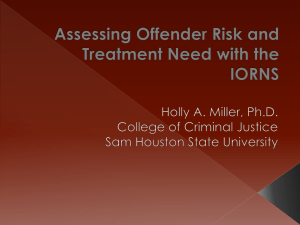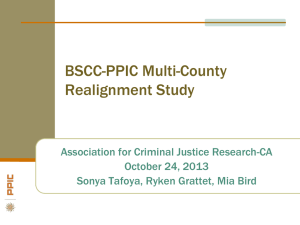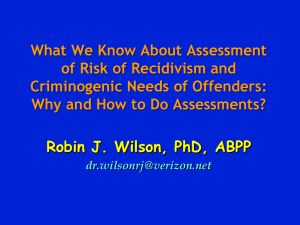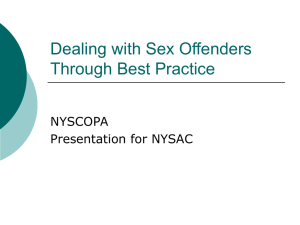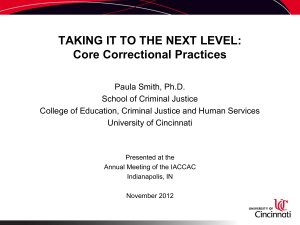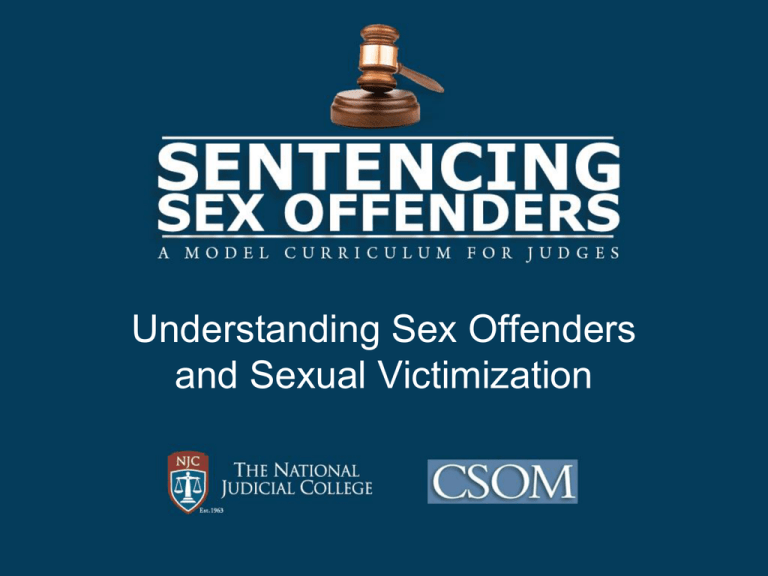
Understanding Sex Offenders
and Sexual Victimization
Learning Objectives
• Name the most common victim-offender
relationships and locations for crimes;
• Discuss the issues surrounding sexual
victimization;
• Describe ways in which sex offenders
differ from one another;
• Understand implications of diversity on
sentencing; and
• Describe some of the current uncertainties
about sex offense and recidivism data.
Research on Judges’ Challenges in
Sex Offender Cases
Incidence and Prevalence Trends
Victim Issues in Court Practices
Uncertainties in Sex Offender Data
Offender Characteristics
Recidivism Research
Dynamics of Sexual Victimization
Overview
Factors that Pose Difficulties
in Sex Offender Cases
• Disproportionate media attention
• Negative public sentiment
• Widespread myths, conflicting information
• Proliferation of sex offender-specific laws
• Imperfect science
What Difficulties Have You Faced?
Research on Judges’ Difficulties
in Sex Offender Cases
Judges’ Difficulties Presiding Over
Sex Offense Cases
Legal/Technical Perspective
More or Much
More Difficult
No More Difficult
(Bumby & Maddox, 1999)
Judges’ Difficulties Presiding Over
Sex Offense Cases (cont.)
Public Scrutiny/Pressure Perspective
More or Much
More Difficult
No More Difficult
(Bumby & Maddox, 1999)
Judges’ Difficulties Presiding Over
Sex Offense Cases
Personal/Emotional Perspective
More or Much No More Difficult
More Difficult
(Bumby & Maddox, 1999)
Specific Decision-Making Difficulties
Reported by Judges
• Pre-existing relationship between
accuser and accused
• Reluctance or refusal of victim to testify
• Limited evidence, lack of corroborating
evidence
(Bumby & Maddox, 1999)
Specific Decision-Making Difficulties
Reported by Judges (cont.)
• Defendant’s injection of reasonable
doubt into circumstances of the crime
• Interpretation and application of (and
limited confidence in) assessments
• Limited information about “what works”
(Bumby & Maddox, 1999)
INCIDENCE AND PREVALENCE TRENDS
Incidence and Prevalence Trends
• Childhood Sexual Abuse
– 1 in 4 girls
– 1 in 6 boys
• Rape
– 1 in 6 women
– 1 in 33 men
(See, e.g., Finkelhor, 1994; Finkelhor et al., 2005; Tjaden & Thoennes, 2006)
Does This Prevalence Data
Compare to Your Experience?
What are the Challenges in Jury
Selection and Management?
Victim-Offender Relationship
Locations Where Victimization Occurs
Reporting Rates
Short- and Long-Term Impact
DYNAMICS OF
SEXUAL VICTIMIZATION
Myth or Fact?
Those who commit sex crimes are
usually known to their victims.
Sexual Victimization of Children and Adolescents:
Victim-Offender Relationship by Victim Age
80%
60%
40%
20%
0%
0 to 5
Family
6 to 11
12 to 14
Acquaintance
15 to 17
Stranger
(Snyder & Sickmund, 2006)
Rape: Victim-Offender Relationship
Female Victims
Strangers
Male Victims
Known
(Tjaden & Thoennes, 2006)
Myth or Fact?
When sexual victimization occurs, it
usually takes place at a location
that is not familiar to the victim.
Most Common Locations Where
Sexual Assaults Occur
• Adult victims
– Victim’s home (39%)
– Home of friend, other relative (24%)
• Child and adolescent victims
– Home (81%)
– School (8%)
(Rennison, 2001; Snyder, 2000; Snyder & Sickmund, 2006)
Myth or Fact?
Reporting rates for sex crimes are
higher than for other kinds of
crimes against persons.
Reporting Rates for Various Crimes
Against Persons
100%
80%
66%
60%
57%
42%
40%
20%
0%
Robbery
Aggravated
Assault
Rape/Sexual
Assault
(Rand, 2008)
Examples of Potential Short- and
Long-Term Impact on Victims
• Fear, anxiety
• Depression, suicidal ideation and attempts
• Self-esteem, self-image difficulties
• Relationship difficulties
• Substance abuse
• Delinquency
• Post-Traumatic Stress Disorder
VICTIM ISSUES IN
THE COURTROOM
Balancing Offender Focus with
Victim Awareness
• System responses that consider
victims as well as offenders
• Policies and practices that are
sensitive to victims’ needs, interests
Roles for Judges
• Be knowledgeable about rape shield laws
• Know legal status of privileged
communications that occur in the context of
victims’ counseling sessions
• Allow support persons for victims during
court proceedings
• Model appropriate, victim-sensitive conduct
• Inquire of impact of plea agreement on
victims
Roles for Judges (cont.)
• Hold pre-trial conferences, motions, or
evidentiary hearings in a manner that does
not intimidate victims
• Be sensitive to the timing of trials
• Allow flexibility in court scheduling to
accommodate the needs of victims
• Minimize court appearances for victims
• Ensure compliance with victims’ rights
legislation
Plea Bargaining and
Prosecution Practices
• Potential unintended consequences
of plea bargains
• Victim advocates
• Victim impact statements
• Vertical prosecution
• Accurate charges
• Specialized units
What Percentage of All Arrests Are
for Sex Offenses?
A. Less than 1%
B. 1 to 10%
C. Greater than 10%
UNCERTAINTIES IN SEX
OFFENDER DATA
Limitations of Sex Offense Data
● Many offenses not reported
– 58%/84% sex offenses not reported
– 32% robberies not reported
● All reports do not lead to arrest
● All arrests do not lead to charges
● All charges do not lead to convictions
● Convictions on lesser charges may
result from plea agreements
Arrests for Sex Crimes:
Adult Males vs. Adult Females
Males
Females
(FBI, 2005)
Myth or Fact?
Individuals can be identified as sex
offenders based on a specific set of
profile characteristics.
Sex Offender Demographics
• Variable:
– Culture/race
– Socioeconomic status
– Employment
– Marital status
Variations in Offending Behaviors
•
•
•
•
•
•
•
Known age of onset
Known targets (victims)
Known motivations
Deviant arousal, interests (paraphilia)
Known patterns of behavior
Known frequency, duration/course
History of detection
Additional Variations Among
Sex Offenders
•
•
•
•
Recidivism risk
Intervention needs
Amenability to treatment
Response to criminal justice
sanctions
Myth or Fact?
As a group, sex offenders have a
very high known recidivism rate.
•
•
•
•
•
•
•
•
What Does Sex Offender
Recidivism Mean and How Is It
Measured?
Conviction of new sex offense
Conviction of a new violent offense
Conviction on any new offense
Violation/revocation of probation/parole
Arrest
New criminal charge
Complaint
Self-disclosed event
Key Recidivism Findings About
Sex Offenders
• Relatively low known sexual
recidivism rates as a group
• Higher rates of known non-sexual
recidivism
• Lower known recidivism rates than
other felony offenders
Known Recidivism Rates for Sex Offenses:
Previous Conviction vs. No Previous Conviction
No Previous Conviction
Previous Conviction
(Harris & Hanson, 2004)
Implications for Sentencing
• Look for heterogeneity of sex
offenders
• Individualize sentences
– Capitalize upon existing judicial
discretion
– Consider assessment data to inform
decisions
Summary
• The incidence of sex crimes is
widespread and sex crimes have a
significant impact on victims.
• Sex offenders usually know their victims
and perpetrate sex crimes in familiar
places.
• Judges need to understand victim issues
and related justice system practices.
Summary (cont.)
• Sex offenders are a diverse population:
– Differ in numerous ways, including known
recidivism risk; and
– Different Diagnoses.
• As a group, sex offenders have relatively
low rates of known recidivism.
• Recidivism is a challenge to define and
measure; research is evolving.



